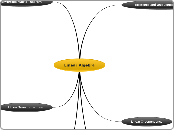Linear Algebra
Invertible Matrix Theorem
A is an invertible, NxN matrix
For all B in R^N, Ax=b has the unique solution x=(A^-1)b
A has N pivot columns
The Columns of A Span R^N
N Pivot Positions
b is a linear combination of the columns of A
x|->Ax maps R^N ONTO R^N
At least ONE solution
x|->AX is ONE-TO-ONE
At Most One Solution
Ax=0 has only the trivial solution
Linearly Independent
The columns of A do not contain the Zero Vector
The Columns of A are Linearly Independent
A^T is invertible
A is row equivalent to I sub n
Let C and D be NxN Matrices
CA=I; AD=I
C=D
Existence and Uniqueness Theorem
Let A be an augmented matrix
If the rightmost column of A is a pivot column
There must exist a row [0 0 ... 0 b]
The System is inconsistent
b is not a linear combination of the columns of A
The System has no solutions
b is not a linear combination of the columns of A
If the rightmost column is not a pivot column
Check for Free Variables
If A contains one or more free variables
The System has Infinitely Many Solutions
Ax=0 has a nontrivial solution
Writing the Solution Set of a Consistent System in Parametric Vector Form
1. Row Reduce the Augmented Matrix to Reduced Eschelon Form
2. Express each basic variable in terms of any free variables appearing in an equation
3. Write a typical solution x as a vector whose entries depend on the free variables, if any
4. Decompose x into a linear combination of vectors (with numeric entries) using the free variables as parameters.
If A contains ONLY basic variables
The System has a Unique Solution
Ax=0 has the trivial solution
Let A be size MxN: The following are logically equivalvent
For each b in R^M, the equation Ax=b has a solution
Each b in R^M is a linear combination of the columns of A
The columns of A span R^M
A has a pivot position in every row
Linear Independence
Linear Independence
X1V1+X2V2+...+XpVp=0 has only the trivial solution
Ax=0 has only the trivial solution
Linear Dependence
There exist weights, C1...Cp, not all zero, such that C1V1+C2V2+...+CpVp=0
One or Two Vectors
One vector is the scalar multiple of another in a set of two vectors
Two or More Vectors
One vector in an arbitrary set S is a linear combination of the others
A set contains more vectors than entries in each vector. That is, any set {V1,...,Vp} in R^N is linearly dependent if P>N
A set S={V1,...,Vp} in R^N contains the zero vector
The Inverse of a Matrix
A=[a b, c d]
If ad-bc is not 0, then A is invertible
If A is an invertible NxN matrix, then for each b in R^N, the equation Ax=b has the unique solution x=(A^-1)b
If ad-bc=0, then A is NOT invertible
A^-1=(1/ad-bc) [d -b,-c a]
Determinant: ad-bc=det A
Linear Transformations
A Transformation, T, is linear if
T(u+v)=T(u)+T(v) for all u,v in the domain of T
T(cu)=cT(u) for all u and scalars c
Note: for all vectors u,v in the domain of T and all scalars c,d
T(0)=0
T(cu+dv)=cT(u)+dT(v)
Standard Matrix of a Linear Transformation
T(x)=Ax for all x in R^N
A= [T(e1) T(e2) ... T(en)]
ONTO
each b in R^M is the image of at least one x in R^N
Ax=b has at least one solution
The Columns of A span R^M
ONE-TO-ONE
each b in R^M is the image of at most one x in R^N
Ax=b has at most one solution
T(x)=0 has only the trivial solution
The columns of A are linearly independent
L U factorization:
Ly=b
Ux=y
